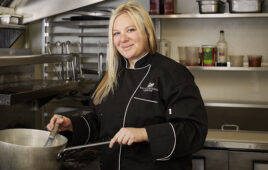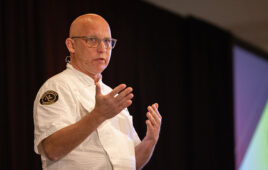Chad Myers, Executive Chef of Dubuque (Iowa) Golf & Country Club, struggles with finding the right balance between traditional comfort foods and more modern, artistic dishes.
Dubuque Golf & Country Club has deep roots in tradition. And so I have conversations with members and long-time staff all the time about being more traditional with menus. But really, what is traditional? What does it mean to be more traditional with food?
I assume when they ask for “traditional food” they’re looking for dishes passed down from generation to generation. Dishes that are personal and family-oriented. Dishes that their grandmothers and great grandmothers used to make. But in some cases, they mean foods that have been consumed over the course of history. Dishes that have been generically passed through generations.
Whose tradition am I supposed to be following? Why are we always trying to be something from the past?
When I was learning how to cook, the tradition was to use canned red apple slices on a piece of kale for garnish or sprinkle paprika and dried parsley on the rim of the plate. It literally makes me laugh out loud when I think about being shown as a young chef that the only way to make something pretty was to sprinkle green sawdust and paprika on the rim of the plate. The more the prettier. Things change. People change. And it’s ok!
I feel like yearning for the past and not being willing to step outside of the box is stagnation. The part I love about being in the food industry is the inherent aversion to stagnation. I like to evolve. I like to take each day and each dish and learn from it. I worked in a call center for almost 3 years. Saying almost the same thing day in and day out was something I knew I wasn’t built for. It felt like I was coasting through life, not challenging myself. So I removed myself from that situation and found food and beverage.
I realize that I live in the heart of the Midwest and that here meat and potatoes rule. But I’m also the Executive Chef of a really amazing country club with generous and kind members who spend lots of money to get things that they can’t get anywhere else. Steaks with mounds of potatoes and piles of vegetables are delicious. So is chicken pot pie, stroganoff, and other comforting culinary delights. And I am more than happy to put out this food. But there are also plates of food that do not have a potato or pile of vegetables—and they are still complete and delicious dishes.
I was recently informed that the only real way to cook green bean casserole is with canned green beans. As someone who prides himself on using fresh, quality ingredients, this was a hard pill to swallow. I have no problem making green bean casserole. I just have a hard time believing that the best way is with mushy, colorless beans that taste like the aluminum that they came in. When I create something, I want it to be the best possible version of itself. Probably one of my favorite things to do is to create. So to be told to do something that I believe goes against everything I strive to be and everything my food represents doesn’t work for me. And it shouldn’t be the standard my members accept either.
I understand that as a club chef we have an umbrella of tastes and preferences to cater to. And I work hard to try to please all people under that umbrella. I struggle with finding the balance between wanting to create works of art on a plate with different textures, flavors and colors with need to serve up traditional fare. Is surf and turf only filet and lobster? Are the best green beans from cans?
One of the most valuable lessons I’ve ever learned in the hospitality business is that it doesn’t matter what I want. It’s what the customer wants. I understand that. And I am not the kind of chef to say no. If a member wants it, and it’s in the cooler, I will cook it and I will cook it in the best way possible. I never want to say no to a member. Afterall, they’re why we’re here. But if we are trying so hard to be the best we can possibly be for our members, then we have to stop pulling from the past. Traditions have a time and place, but so do new ideas—today more than ever. And change is necessary and needed.
Creating the best version of something is not too far out of the box. I’m not trying to be Grant Achatz at Alinea where science meets art meets food. I don’t have the skillset for that or the audience. Am I alone in this struggle? Are there other club chefs out there who have successfully bridged the gap between modern and traditional? Is it more than just the food that changes or is it the total mindset that is important?
I would love to see menus from modern clubs. And I would love to hear stories from chefs who saw that moving in a new direction was a challenging and necessary endeavor that reaped huge rewards for their clubs. Tell me your stories. I’m all ears.




